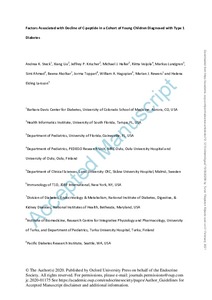Factors Associated with Decline of C-peptide in a Cohort of Young Children Diagnosed with Type 1 Diabetes
Steck Andrea K; Liu Xiang; Krischer Jeffrey P; Haller Michael J; Veijola Riitta; Lundgren Markus; Ahmed Simi; Akolkar Beena; Toppari Jorma; Hagopian William A; Rewers Marian J; Elding Larsson Helena
https://urn.fi/URN:NBN:fi-fe2021042823699
Tiivistelmä
Context: Understanding factors involved in the rate of C-peptide decline is needed to tailor therapies for type 1 diabetes (T1D).
Objective: Evaluate factors associated with rate of C-peptide decline after T1D diagnosis in young children.
Design: Observational study.
Setting: Academic centers.
Participants: 57 participants in The Environmental Determinants of Diabetes in the Young (TEDDY) enrolled at 3 months of age and followed until T1D and 56 age-matched children diagnosed with T1D in the community.
Intervention: A mixed meal tolerance test was used to measure the area under the curve (AUC) C-peptide at 1, 3, 6, 12 and 24 months post-diagnosis.
Outcome: Factors associated with rate of C-peptide decline during the first 2 years post-diagnosis were evaluated using mixed effects models adjusting for age at diagnosis and baseline C-peptide.
Results: Adjusted slopes of AUC C-peptide decline did not differ between TEDDY subjects and community controls (p=0.21), although the former had higher C-peptide baseline levels. In univariate analyses combining both groups (n=113), younger age, higher weight and BMI z-scores, female sex, increased number of islet autoantibodies, and IA-2A or ZnT8A positivity at baseline were associated with higher rate of C-peptide loss. Younger age, female sex and higher weight z-score remained significant in multivariate analysis (all p<0.02). At three months after diagnosis, higher HbA1c became an additional independent factor associated with higher rate of C-peptide decline (p<0.01).
Conclusion: Younger age at diagnosis, female sex, higher weight z-score, and HbA1c were associated with higher rate of C-peptide decline after T1D diagnosis in young children.
Kokoelmat
- Rinnakkaistallenteet [27094]
